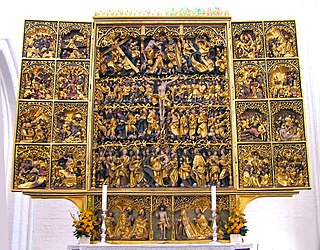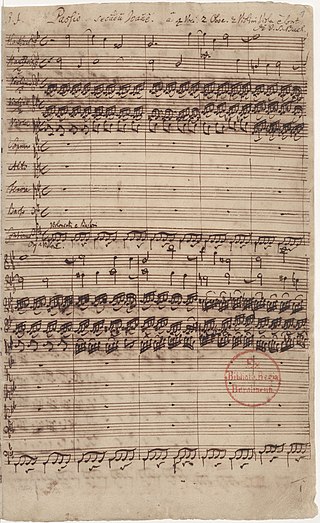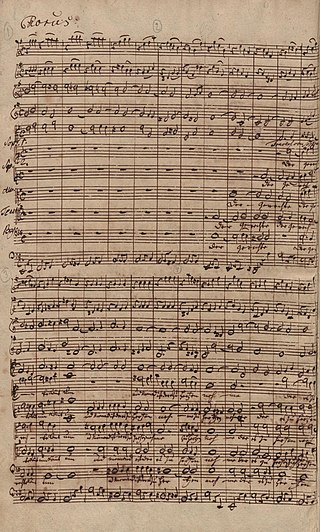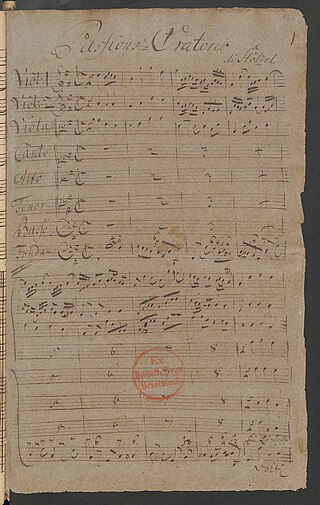
Carl Heinrich Graun was a German composer and tenor. Along with Johann Adolph Hasse, he is considered to be the most important German composer of Italian opera of his time.
This is a list of notable events in music that took place in the year 1734.

Gottfried August Homilius was a German composer, cantor and organist. He is considered one of the most important church composers of the generation following Bach's, and was the main representative of the empfindsamer style.
As Kapellmeister at Hamburg from 1768 to 1788, Carl Philipp Emanuel Bach composed 21 settings of the Passion narrative and 1 Passion oratorio.

In Christian music, a Passion is a setting of the Passion of Christ. Liturgically, most Passions were intended to be performed as part of church services in the Holy Week.
Andreas Karasiak is a German classical tenor in opera and concert.
As Thomaskantor, Johann Sebastian Bach provided Passion music for Good Friday services in Leipzig. The extant St Matthew Passion and St John Passion are Passion oratorios composed by Bach.

Roderich Kreile is a Lutheran church musician, choir director and university teacher. Since 1997, he has been the director of the Dresdner Kreuzchor at the Kreuzkirche, Dresden, as the 28th Kreuzkantor since the Reformation.

The structure of the St John Passion, BWV 245, a sacred oratorio by Johann Sebastian Bach, is "carefully designed with a great deal of musico-theological intent". Some main aspects of the structure are shown in tables below.

Tristis est anima mea is a sacred motet for five voices attributed to Johann Kuhnau, Thomaskantor in Leipzig. The text is the second responsory at Tenebrae for Maundy Thursday, one of the Latin texts kept in the liturgy after the town converted to Lutheranism.

Wer ist der, so von Edom kömmt is a pasticcio Passion oratorio based on compositions by Carl Heinrich Graun, Georg Philipp Telemann, Johann Sebastian Bach and others. The pasticcio was assembled around 1750.
"Ein Lämmlein geht und trägt die Schuld" is a Lutheran hymn relating to the Passion of Christ. The title may also refer to various compositions:
Martin Janus was a German Protestant minister, church musician, hymnwriter, teacher and editor. He wrote the lyrics of the hymn "Jesu, meiner Seelen Wonne", which became popular in the arrangement of a Bach chorale as Jesu, Joy of Man's Desiring.

Ein Lämmlein geht und trägt die Schuld, also known by the title of its earliest extant printed libretto, Die leidende und am Creutz sterbende Liebe Jesu, is a Passion oratorio by Gottfried Heinrich Stölzel, composed in 1720. Its opening chorus is based on Paul Gerhardt's "Ein Lämmlein geht und trägt die Schuld" and its usual hymn tune, Wolfgang Dachstein's "An Wasserflüssen Babylon" melody.

"Ein Lämmlein geht und trägt die Schuld" is a Lutheran Passion hymn in German by Paul Gerhardt. The hymn text was first published in Johann Crüger's Praxis Pietatis Melica, starting from the lost 1647 edition. Wolfgang Dachstein's 16th-century "An Wasserflüssen Babylon" melody is commonly indicated as its hymn tune, although other settings exist.

Daniel Vetter was an organist and composer of the German Baroque era.

Der Gerechte kömmt um, BWV 1149, is a motet for SSATB singers and instrumental ensemble, which, for its music, is based on the five-part a cappella motet Tristis est anima mea attributed to Johann Kuhnau, and has the Luther Bible translation of Isaiah 57:1–2 as text. The arrangement of the Latin motet, that is, transposing it to E minor, adjusting its music to the new text, and expanding it with an instrumental score for two traversos, two oboes, strings and basso continuo, is attributed to Johann Sebastian Bach. The setting is found in a manuscript copy, likely written down in the 1750s, of Wer ist der, so von Edom kömmt, a Passion oratorio which is a pasticcio based on compositions by, among others, Carl Heinrich Graun, Georg Philipp Telemann and Bach. Likely Der Gerechte kömmt um existed as a stand-alone motet, for example for performance on Good Friday or at a funeral, before being adopted in the pasticcio.
Clemens Bosselmann is a German conductor and church musician, working since 2018 as director of music (Kantor) at the Christophoruskirche in Wiesbaden-Schierstein, Hesse. He is the choral conductor of the concert choir Schiersteiner Kantorei where he expanded the concert choir's repertoire with 20th-century music and rarely performed choral works.











